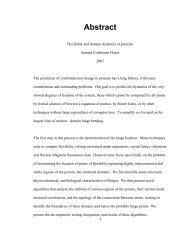Introduction to X-ray Crystallography
Introduction to X-ray Crystallography
Introduction to X-ray Crystallography
- No tags were found...
Create successful ePaper yourself
Turn your PDF publications into a flip-book with our unique Google optimized e-Paper software.
Contributions <strong>to</strong> this lecture:Yong Xiong, PhDYale, Department of Molecular Biophysics & BiochemistryYufeng Zhou, PhDYale, Department of Cellular & Molecular PhysiologyRecommended Course @ Yale: MB&B 720aMacromolecular Structure and Biophysical AnalysisAdditional Resources:<strong>Crystallography</strong> Made Crystal Clear: A Guide for Users of Macromolecular Modelsby Gale Rhodes (Third Edition, 2006 Elsevier/Academic Press)CMCC Home Page: http://spdbv.vital‐it.ch/TheMolecularLevel/CMCC/index.html“<strong>Crystallography</strong> 101” http://www.ruppweb.org/X<strong>ray</strong>/101index.html“<strong>Introduction</strong> <strong>to</strong> X‐<strong>ray</strong> crystallography” http://vimeo.com/7643687http://ucx<strong>ray</strong>.berkeley.edu/~jamesh/movies/movies demonstrating diffraction, resolution, data quality, and refinement.
“Just as we see objects around us by interpreting the light reflected from them,x‐<strong>ray</strong> crystallographers "see" molecules by interpreting x‐<strong>ray</strong>s diffracted from them.”‐ Gale Rhodes• There's a limit <strong>to</strong> how small an object can be seen under a light microscope.• The diffraction limit: you can not image things that are much smaller thanthe wavelength of the light you are using.• The wavelength for visible light is measured in hundreds of nanometers,while a<strong>to</strong>ms are separated by distances of the order of 0.1nm, or 1Å.Yong Xiong
Experimental Determination of A<strong>to</strong>mic Resolution StructuresX‐<strong>ray</strong>NMRX‐<strong>ray</strong>sDiffractionPatternRFRFResonanceH0‣Direct detection ofa<strong>to</strong>m positions‣Crystals‣Indirect detection ofH-H distances‣In solutionOther methods for determining protein structures:‐EM, Cryo‐EM, ESR/Fluorescence
Yufeng Zhouhttp://www.noble.org/PlantBio/Wang/crystallography.html
Why Crystals?Yong Xiong
Some Crystallization Methods:Yong Xiong
Data Collection<strong>Crystallography</strong> 101
Synchrotron X‐<strong>ray</strong> SourcesLab x‐<strong>ray</strong> sources @ 1.54 Å VS. Synchrotron @ 0.5 Å ‐ 2.5 Å.NSLS BNLALS BerkeleyAPS ChicagoCHESS Ithaca
Image of diffraction
Most famous X‐<strong>ray</strong> diffraction pattern
Most famous X‐<strong>ray</strong> diffraction pattern
• © 2006• Academic Press
The information we get from a single diffraction experimentAnalyze the patternof the reflections(a) space group of the crystal(b) unit cell dimensionsc ba
Yong Xiong
Electron density mapBuilding a structure model• © 2006• AcademicPress
The importance of resolutionExperimental electron density map createdfrom multi‐wavelength data collected at SSRLbeam line 1‐5 on a Gold derivative of tetanus Cfragment.Example of high quality Experimental datawhere very little refinement has been applied<strong>to</strong> fit a tyrosine in<strong>to</strong> the density map.http://www.ruppweb.org/X<strong>ray</strong>/101index.html
Yale's Thomas Steitz shared 2009 Nobel Prize in Chemistry for this structure
PDB GrowthCummulativeYearly <strong>to</strong>talPDB has~ 70,000 structuresexample:~ 1,000 membrane proteinsWhat species are the structures from?
Tools for Viewing Structures• Jmol– http://jmol.sourceforge.net• PyMOL– http://pymol.sourceforge.net• Swiss PDB viewer– http://www.expasy.ch/spdbv• Mage/KiNG– http://kinemage.biochem.duke.edu/software/mage.php– http://kinemage.biochem.duke.edu/software/king.php• Rasmol– http://www.umass.edu/microbio/rasmol/










